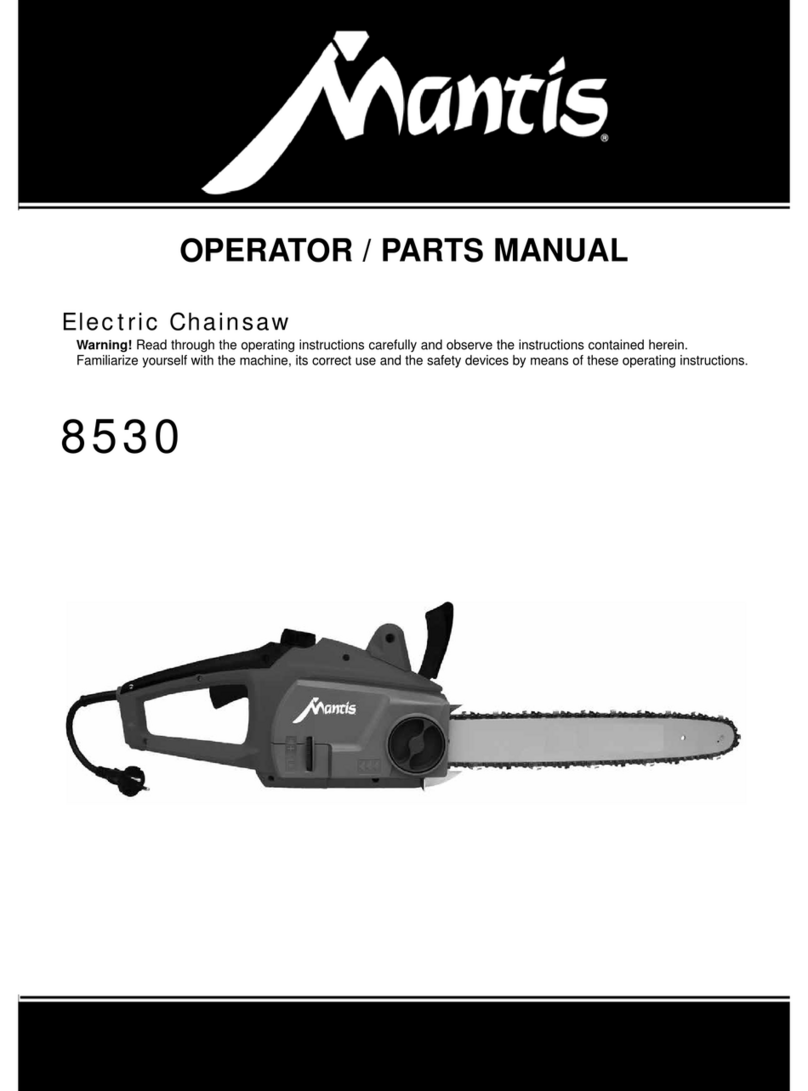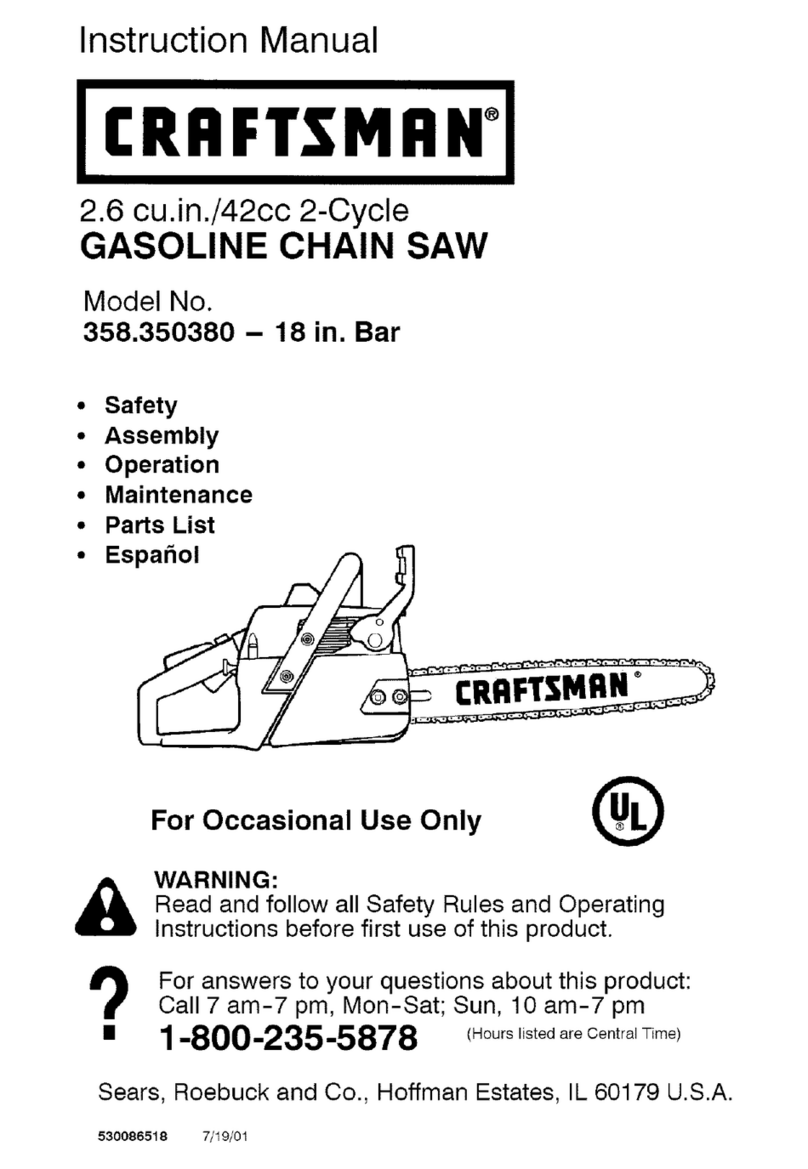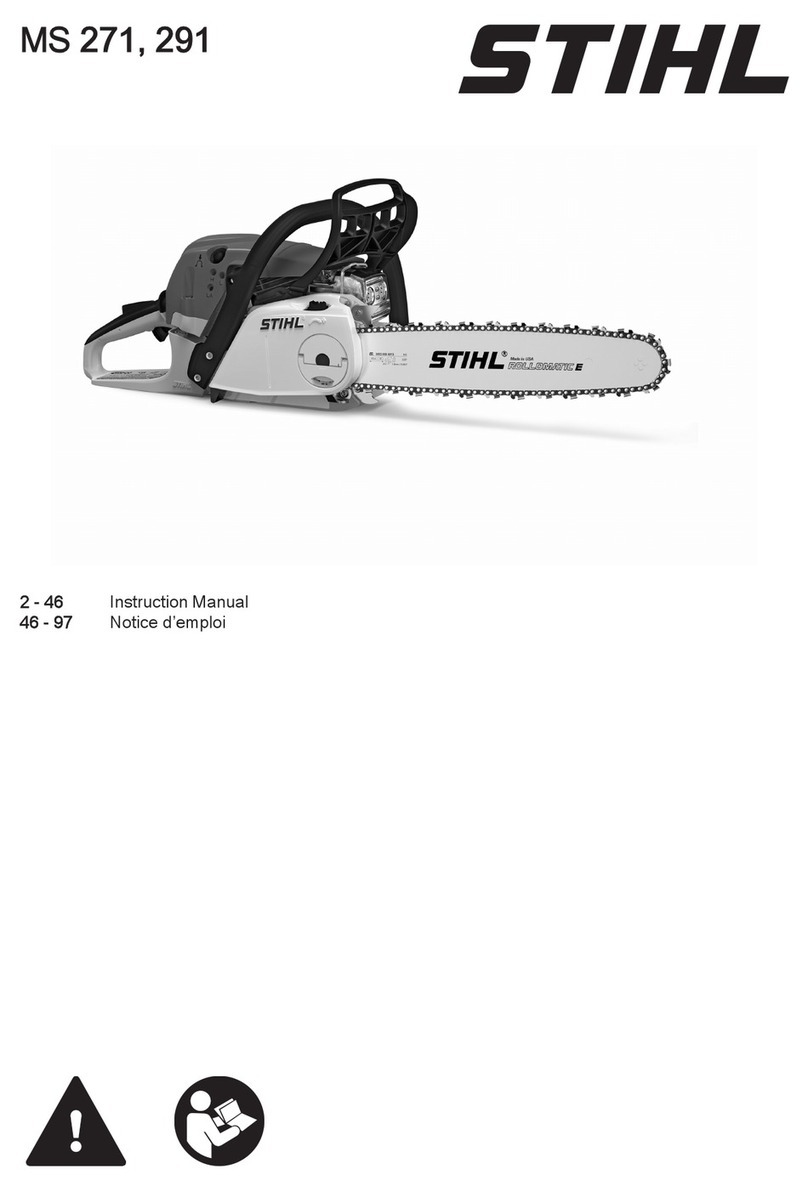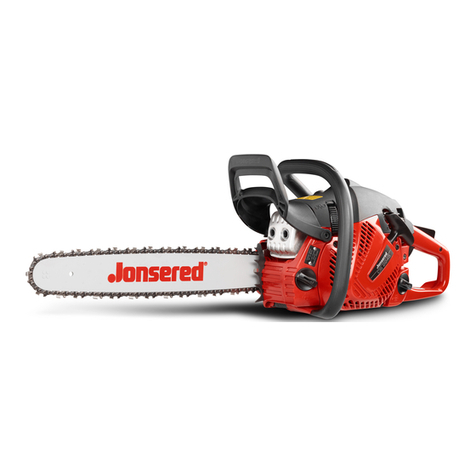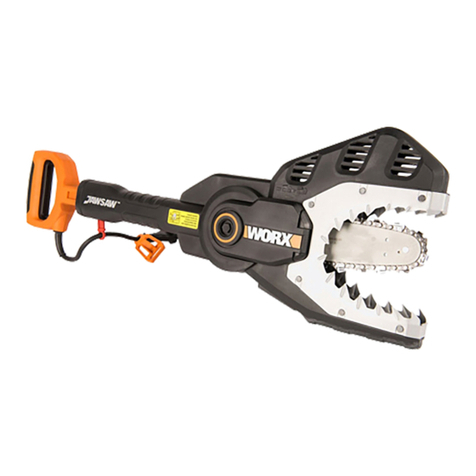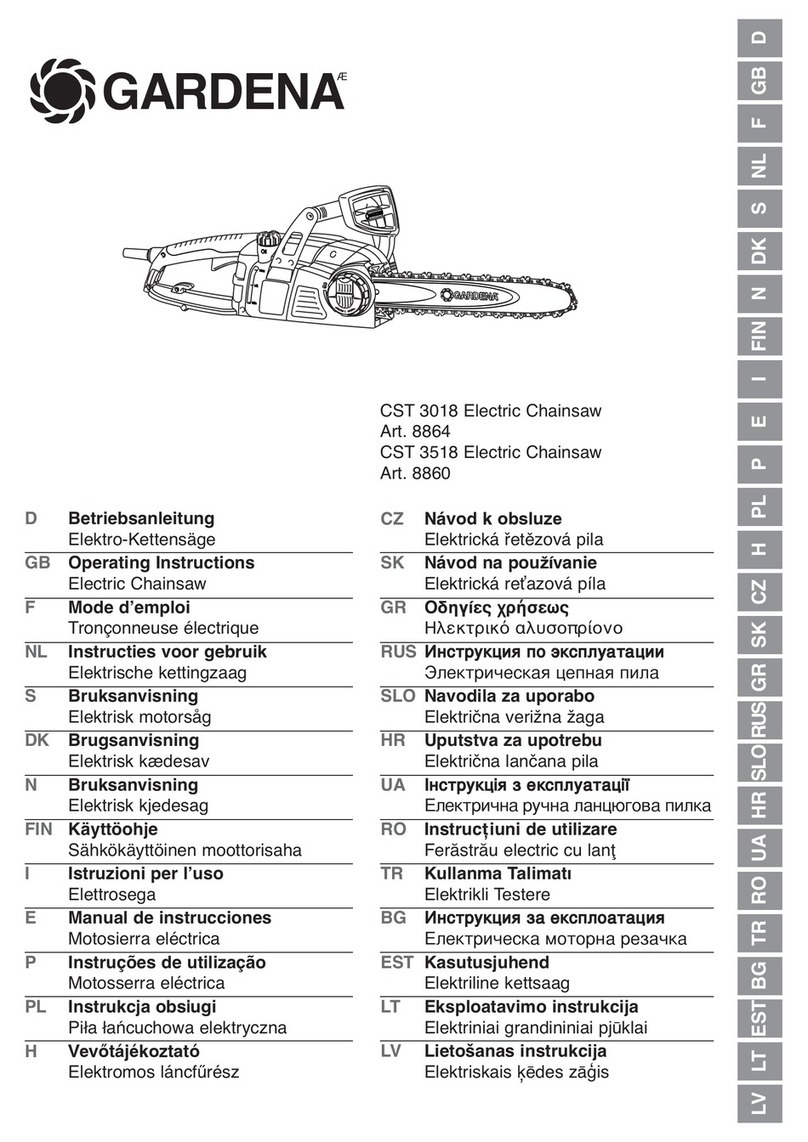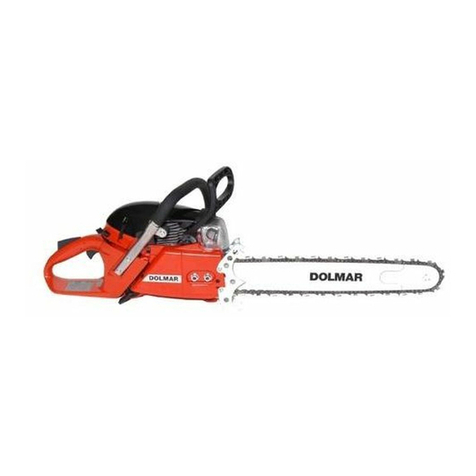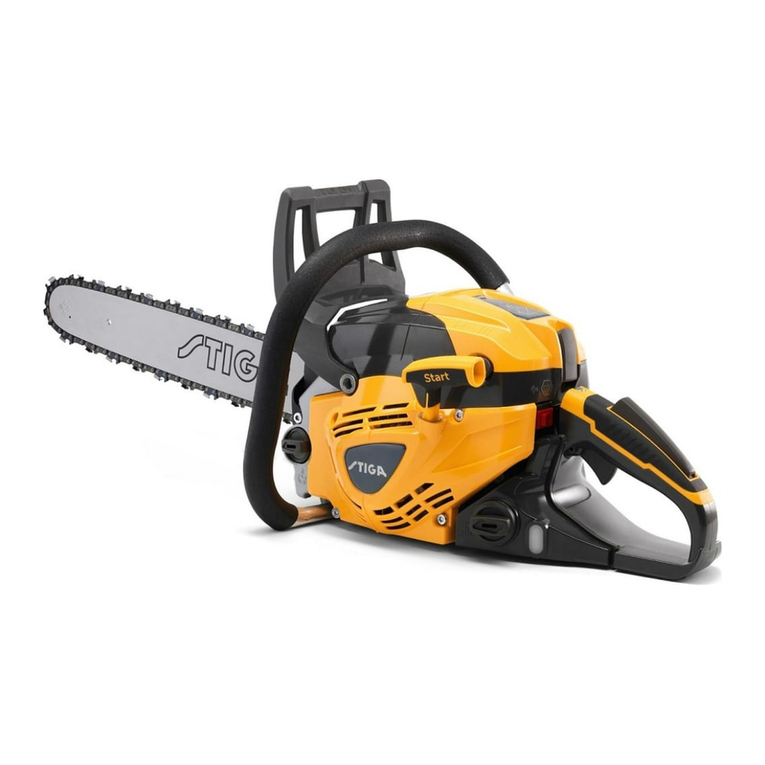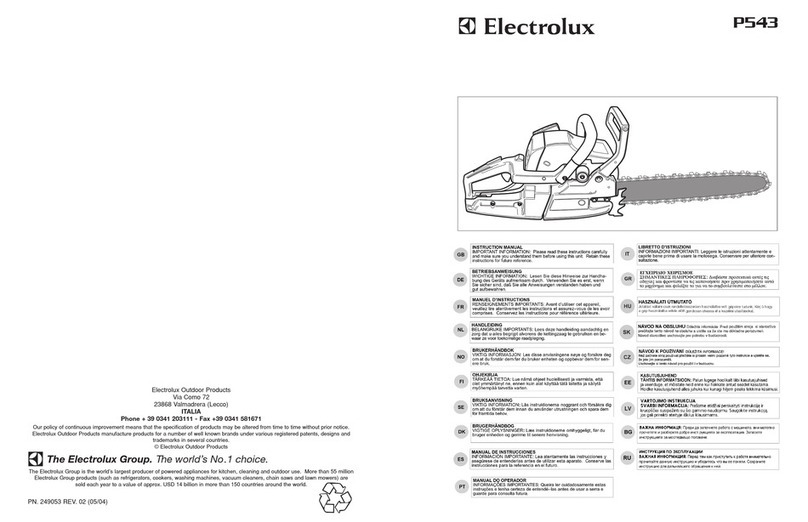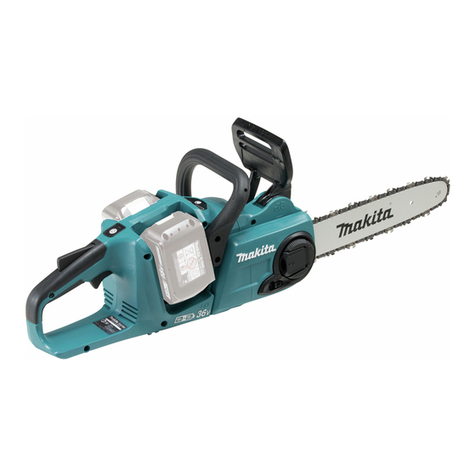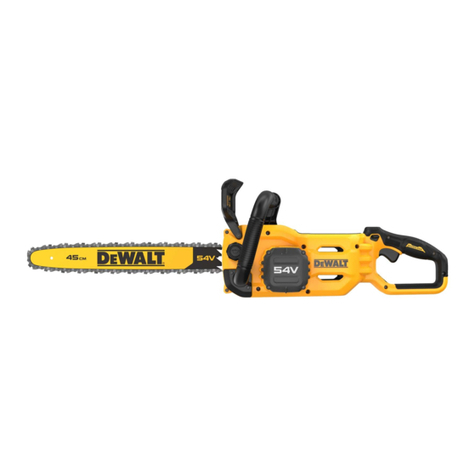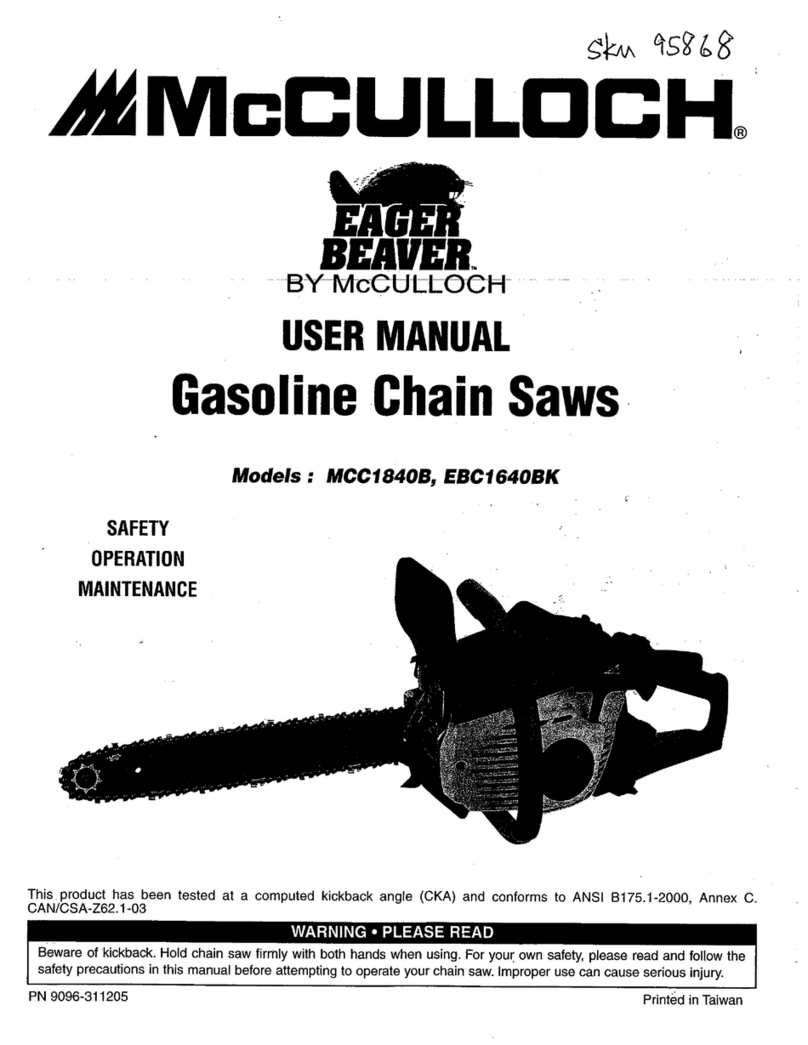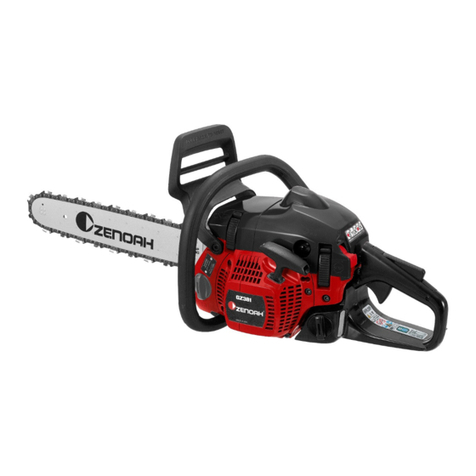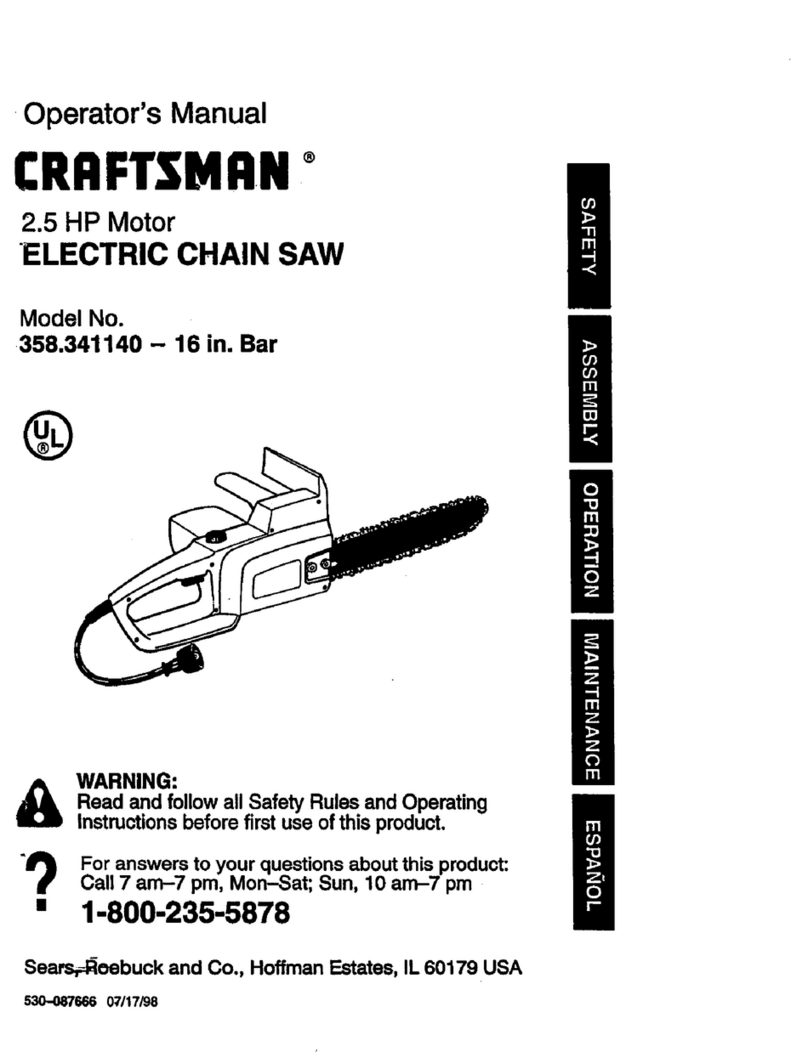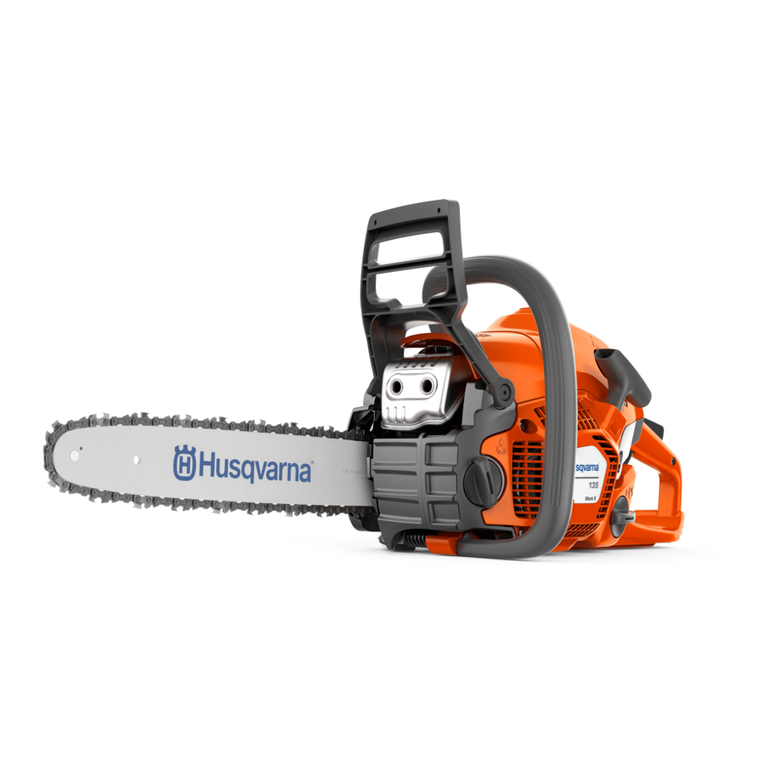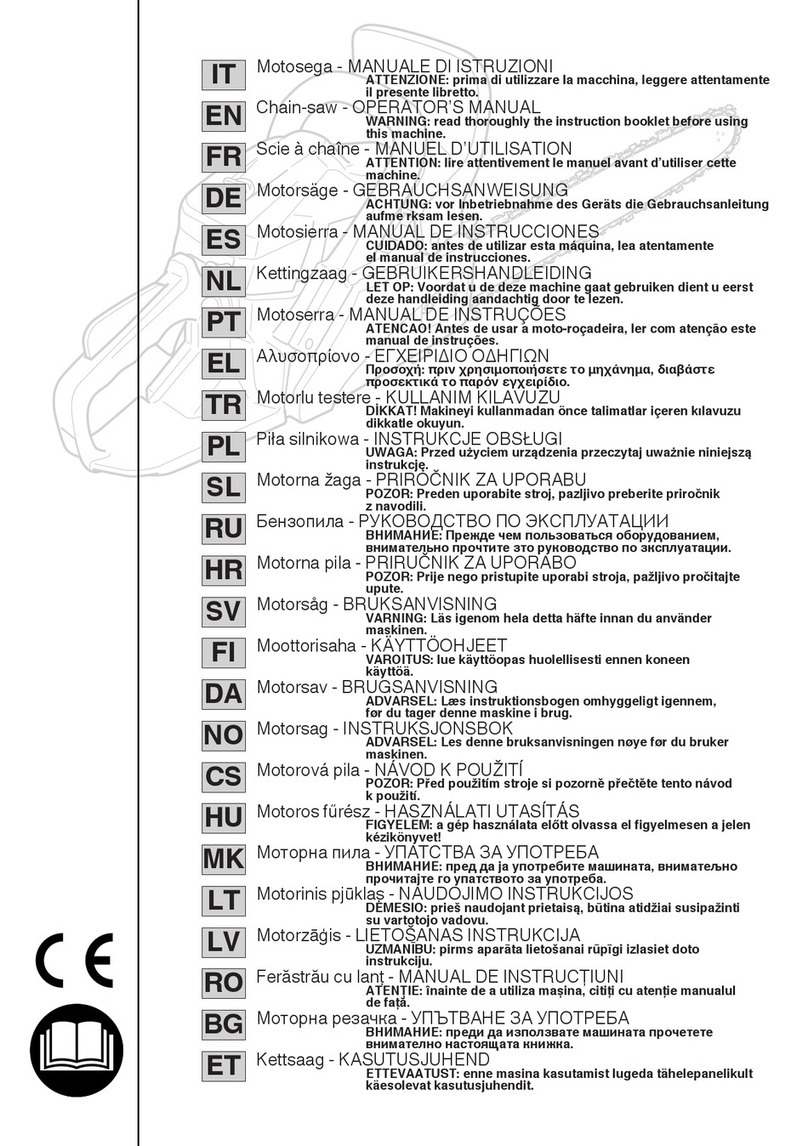Mantis 8520-00-38 User manual

Tronçonneuse électrique - Traduction du mode d’emploi d’origine
Elektro-Kettensäge - Originalbetriebsanleitung
Electric Chainsaw - Translation of the original Operating Instructions
8520-00-38
8520-00-40


1
1215
1
9
16
87
A
B
34
5
3 mm
6

2
17
8
DE
A Fällrichtung
B Gefahrenzone
C Fluchtbereich
GB
A Felling direction
B Danger area
C Escape area
FR
A Direction de chute
B Zone de danger
C Zone de retraite
9
724
direction of fall
Direction de chute
Fällrichtung
notch
Entaille
Kerbe
felling back cut
Coupe de chute
Fällschnitt
2 inches
50 mm
hinge
Pont
Steg
1
2
10
2 inches
50 mm

3
1
12 Cut from top (overbuck); avoid cutting earth
Couper par le dessus. Ne pas couper dans le sol
Schnitt von oben ausführen. Nicht in den Boden sägen
1
2
13
1nd cut underbuck (1/3 diameter) to avoid splintering
La première coupe du bas (1/3 de diamètre) pour éviter les éclats.
Erster Schnitt von unten (1/3 Durchmesser) um Splittern zu vermeiden.
2nd cut overbuck (2/3 diameter) to meet 1st cut (to avoid pinching)
La deuxième coupe d’en haut (2/3 de diamètre) jusqu’au niveau de la première coupe (pour éviter le blocage)
Zweiter Schnitt von oben (2/3 Durchmesser) auf Höhe des ersten Schnitts (um Einklemmen zu vermeiden)
11 limb cut
Direction de coupe pour l’émondage
Schnittrichtung beim Entasten
Keep work off ground leave support limbs until lod is cut
Tenir à l’écart du sol. Laisser les branches inférieures de soutien jusqu’à ce que le tronc soit scié
Vom Boden fernhalten. Unterstützende Äste stehen lassen, bis der Stamm zersägt ist

15 Stand on uphill side when cutting, because log may roll
Lors de la coupe se positionner à l’extrémité du tronc du fait que le tronc peut se dérouler
Beim Sägen am Hang oberhalb vom Stamm stehen, da der Stamm wegrollen kann
14 1nd cut overbuck (1/3 diameter) to avoid splintering
La première coupe d’en haut (1/3 de diamètre) pour éviter les éclats.
Erster Schnitt von oben (1/3 Durchmesser) um Splittern zu vermeiden.
2nd cut underbuck (2/3 diameter) to meet 1st cut (to avoid pinching)
La deuxième coupe du bas (2/3 de diamètre) jusqu’au niveau de la première coupe (pour éviter le blocage)
Zweiter Schnitt von unten (2/3 Durchmesser) auf Höhe des ersten Schnitts, um Einklemmen zu vermeiden
1
2
4

5
DE
1 Ölsichtfenster
2 Vorderer Handgriff
3 Öltankverschluss
4 Vorderer Handschutz
5 Schwert
6 Sägekette
7 Knebelschraube
8 Ritzeldeckel
9 Schalter
10 Hinterer Handschutz
11 Hinterer Handgriff
12 Netzleitung mit Stecker
13 Schwertschutz
14 Fällgriff
15 Sperrknopf
16 Rändelrad zur Kettenschnellspannung
GB
1 Oil inspection window
2 Front handle
3 Oil tank cap
4 Front hand protection
5 Blade
6 Saw chain
7 T-screw
8 Pinion lid
9 Switch
10 Rear hand protection
11 Rear handle
12 Mains connection with plug
13 Blade protection
14 Fell handle
15 Stopping button
16 Knurling wheel for quick chain tension adjustment
FR
1 Ecran témoin pour niveau d‘huile
2 Poignée avant
3 Couvercle du réservoir d‘huile
4 Protège-main avant
5 Guide
6 Chaîne de la scie
7 Vis à garret
8 Couvercle à pignon
9 Interrupteur
10 Protège-main arrière
11 Poignée arrière
12 Câble avec che
13 Protège-guide
14 Poignée d‘abattage
15 Bouton d‘arrêt
16 Roue à molette pour une tension rapide de la chaîne
13
7
8
16
56
14
4
2
10
9
15
11
12 3
1

GB | Operating Instruction
GB-1
Translation of the original Operating Instructions
CONTENT Page
1. Introduction to the Operating Instructions GB-2
2. Illustration and explanation of pictograms GB-2
3. Technical Data GB-2
4. General safety instructions GB-3
5. General safety information for power tools GB-3
1) Safety at the workplace
2) Electrical safety
3) Personal safety
4) Use and handling of the power tool
5) Service
6) Emissions
7) Safety instructions for chain saws:
8) Causes of kickbacks and how to avoid them:
9) Important instructions for your personal safety
a) General safety instructions
b) Instructions on using the chain saw safely
c) Warning to the danger of recoil (“kickback”)
d) Instructions on safe working techniques
6. Starting up GB-6
1) Filling the oil tank
2) Assembling the blade and chain
3) Connecting the chainsaw
4) Switching on
7. Safety devices on your chain brake GB-7
1. Chain brake
2. Rundown brake
3. Safety starting lock
4. Chain catch bolt
8. Instructions on working properly with the chain saw GB-7
a) Felling a Tree
b) Notching Undercut
c) Felling Back Cut
d) Limbing a Tree
e) Bucking a Log
9. Maintenance and Servicing GB-8
Transport
10. In the case of technical problems GB-8
11. Repair Service GB-9
12. Waste disposal and environmental protection GB-9
13. EC Declaration of Conformity GB-9
MANTIS LIMITED WARRANTY GB-10

GB-2
GB | Operating Instruction
1. Introduction to the Operating Instructions
These Operating Instructions are intended to facilitate your becoming acquainted with the machine and using it in
accordance with the regulations. The Operating Instructions contain important information on how to use the machine
safely, correctly and economically. Observing this information will help increase the reliability and working life of the
machine. The Operating Instructions must always be at hand when the machine is being used.
They must be read and observed by every person dealing with the machine, whether operating, servicing or transporting it.
In addition to the Operating Instructions and the applicable rules of the prevention of accidents valid in the country
of use and on site, the generally recognised rules on working safely and correctly must be observed as well as the
accident prevention rules of the relevant professional associations.
3. Technical Data
The devices are manufactured in accordance with the provisions of DIN EN 60745-2-13 and fully comply with the
provisions of the German Product Safety Act.
Electric Chainsaw 8520-00-38 UK
8520-00-40 Europe
Rated Voltage V~ 230
Nominal Frequency Hz 50
Fuse (time lag) A 16
Rated Output W 2400
Guide Bar mm 400
Cutting length mm 380
Speed m/sec ca. 12
Weight kg 4,85
Oil ml 200
All models with automatic chain lubrication and mechanical chain brake and rundown brake.
The type designation of the chain you will nd on the type plate.
Class of Protection: II/ DIN-EN 60745-1
Interference Suppression: according to EN-55014
Noise emission information in accordance with the German Product Safety Act (ProdSG) and the EC Machine Direc-
tive:
Noise emission values EN-60745: Sound Pressure Level LpA 90 dB (A) [K=3,0 dB (A)]
Vibration values in accordance with EN 60745: Weighted acceleration handle max. 6,1 m/s2 [K=1,5 m/s2 ]
Attention: This chain saw is only intended for cutting wood !
Electric Chainsaw
1 Wear eye, head and ear protection!
2 Warning!
3 Read operation instructions before use
4 Do not subject this electric power tool to rain
5 Remove plug immediately if the power flex is damaged or cut.
6 Attention, kick-back!
7 Hold tool with both hands!
8 Attention: Environmental Protection! This device may not be disposed of with general/ household waste. Dispose of
only at a designated collection point.
2. Illustration and explanation of pictograms
1 2 3 4 5 6 7 8

GB | Operating Instruction
GB-3
4. General safety instructions
Noise emission information in accordance with the Ger-
man Product Safety Act (ProdSG) and the EC Machine
Directive: the noise pressure level at the place of work
can exceed 80 dB(A). In such cases the operator will
require noise protection (e.g. wearing of ear protectors).
Attention: Noise protection! Please observe the local
regulations when operating your device.
5. General safety information for power tools
Warning! Read all safety-related information
and safety instructions! Failure to observe the
safety information and instructions may result in
electric shock, burns and/or severe injury.
Keep the safety information and instructions for
future reference.
The term ‘power tool’ as used in the safety information
and instructions includes both mains-operated tools
(with power cord) and battery-operated tools (without
power cord).
1) Safety at the workplace
a) Keep your working area clean, tidy and well-lit.
Disorder and poorly lit working areas may result in
accidents.
b) Do not operate the power tool in potentially
explosive environments containing combusti-
ble uids, gases or dusts. Power tools generate
sparks that may ignite dusts or fumes.
c) Keep children and other persons away while
you are operating the power tool. Distractions
may result in the operator loosing control over the
tool.
2) Electrical safety
a) The mains plug of the power tool must t into
the mains socket. The plug must not be modi-
ed in any way. Do not use adapter plugs/con-
nectors in combination with tools with protec-
tive earthing. Unmodied plugs and tting sockets
reduce the risk of electric shock.
b) Avoid physical contact with earthed surfaces as
pipes, heaters, ovens and refrigerators. There is
an increased risk of electric shock if your body is
earthed.
c) Keep the tool out of the rain or moisture in
general. The penetration of water into a power tool
increases the risk of electric shock.
d) Do not use the cord to carry or hang up the
tool or to pull the plug out of the socket. Keep
the cord away from heat, oil and sharp edges
or moving parts of the tool. Damaged or tangled
cords increase the risk of electric shock.
e) When operating a power tool outdoors, use ex-
clusively extension cords that are approved for
outdoor-use. The use of an extension cord that is
suitable for outdoor use reduces the risk of electric
shock.
f) If the operation of a power tool in a moist envi-
ronment cannot be avoided it is highly recom-
mended to use a residual current device (RCD).
The use of an RCD reduces the risk of electric
shock.
3) Personal safety
a) Always pay attention to what you do and apply
reasonable care when working with a power
tool. Do not use the power tool when you are
tired or under the inuence of medication,
drugs or alcohol. When working with power tools,
even a short moment of inattentiveness may result
in severe injury.
b) Wear personal protection equipment and al-
ways wear eye protection (safety goggles).
Wearing personal protection equipment as a dust
mask, nonslip safety shoes, safety helmet or ear
protectors (depending on the type and application
of the tool) reduces the risk of injury.
c) Avoid unintentional operation. Make sure that
the power tool is switched off before you con-
nect it to the mains supply and/or the battery
and whenever you pick up or carry the tool.
When carrying the tool with your nger on the on/
off switch or connecting the tool to the mains supply
with the switch in ‘ON’ position, this may result in
accidents.
d) Remove adjustment tools or wrenches and
the like before you switch the power tool on. A
wrench or other tool that is inside or on a rotating
part of the tool may cause injury.
e) Avoid unusual postures. Make sure to have a
safe footing and keep your balance at all times.
This will allow you to better control the power tool
in unexpected situations.
f) Wear suitable clothes. Do not wear wide cloth-
ing or jewellery. Keep your hair, clothes and
gloves clear of all moving parts. Loose clothing,
jewellery or long hair may get caught in moving
parts.
g) If dust extraction/collection devices are pro-
vided make sure that they are connected and
used properly. The use of a dust extraction device
may reduce risks caused by dust.
4) Use and handling of the power tool
a) Do not overtax the power tool. Use the power
tool intended for your type of work in each
case. The use of the suitable power tool within the
stated range of performance makes working more
effective and safer.
b) Do not use a power tool with a damaged switch.
A power tool that cannot be switched on or off any
more is dangerous and must be repaired.
c) Pull the mains plug and/or remove the battery
before adjusting a tool, changing accessories
or putting the tool aside. This precaution avoids
the unintentional start of the tool.
d) Store power tools that are currently not used
out of the reach of children. Do not allow per-
sons to use the tool if they are not familiar with
the tool or these instructions. Power tools are
dangerous if used by inexperienced persons.

GB-4
GB | Operating Instruction
e) Thoroughly maintain your power tool. Check
whether moving parts are working properly and
are not jamming/sticking, and whether parts are
broken or otherwise damaged in a way that may
affect the function of the power tool. Have dam-
aged parts repaired before using the tool. Many
accidents are the result of poorly maintained power
tools.
f) Keep cutting tools sharp and clean. Thoroughly
maintained cutting tools with sharp cutting edges
are jamming less often and are easier to guide.
g) Use power tools, accessories, add-on tools,
etc. in accordance with these instructions and
in the way prescribed for the respective type
of tool. You should also consider the working
conditions and the work to be carried out. The
use of power tools for purposes other than those
intended for the respective tool may result in dan-
gerous situations.
5) Service
a) Have the power tool serviced by qualied tech-
nical personnel only; repairs should be carried
out using exclusively original spare parts. This
will ensure the continued safe operation of the
power tool.
6) Emissions
- The specied vibration emission value was meas-
ured by a standardized test methods and can
compare with other power tools are used.
- The specied vibration emission value can also be
necessary for the assessment of work breaks are
used.
- The specied vibration emission value can vary
during the actual use of the electric tool by specify-
ing the value, depending on the way how to use the
power tool.
- Note: You create the privilege against vascular
pulsations of the hands in time breaks
7) Safety instructions for chain saws:
• Keep all parts of your body clear of the chain
while the saw is running. Before starting the saw,
make sure that the chain does not touch any ob-
jects. When working with a chain saw, even a short
moment of inattentiveness may result in clothes or
parts of the body being caught by the chain.
• Always hold the chain saw with your right hand
at the rear handle and your left hand at the front
handle. Holding the chain saw differently (left hand
– rear handle / right hand – front handle) during
operation will increase the risk of injury and is not
permitted.
• Hold the electric equipment by its insulated
handle surfaces, as the chainsaw can come into
contact with its own mains power cable. If the
chainsaw comes into contact with a live cable, it can
energise metal parts of the equipment and cause an
electric shock.
• Wear eye and hearing protection. Other personal
protection equipment for the head, hands, legs
and feet is recommended. Proper protective cloth-
ing and protection equipment reduce the risk of injury
caused by thrown-about wood chips and accidental
contact with the chain.
• Do not operate the chain saw on trees. Operating
a chain saw while situated on a tree involves a high
risk of injury.
• Make sure to have a safe stand at any time, and
only use the chain saw when standing on solid,
safe and level ground. A slippery ground or instable
surfaces as the steps of a ladder may lead to loosing
balance or the control over the chain saw.
• When cutting a branch that is under tension take
into account that it will spring back. When the
tension of the wood bres is released the tensioned
branch may hit the operator and/or the chain saw
resulting in a loss of control.
• Apply particular caution when cutting brush and
young trees. The thin material may get caught in the
chain and hit you or throw you off balance.
• Carry the switched-off chain saw using the front
handle with the chain pointing away from your
body. Always put on the protection cover when
transporting or storing the chain saw. The careful
handling of the chain saw reduces the risk of acci-
dentally touching the sharp cutting chain.
• Follow the instructions for lubrication, chain
tension and changing accessories. An improperly
tensioned or lubricated chain may either break or
considerably increase the risk of a kickback.
• Keep the handles dry, clean and free from oil and
grease. Fatty, oily handles are slippery and may lead
to a loss of control.
• Use the chain saw for cutting wood only! Do not
use the chain saw for works it is not designed for.
– Example: Do not use the chain saw for cutting
plastics, brickwork or other construction materi-
als that are not made of wood. The use of the chain
saw for applications, for which it is not designed, may
result in dangerous situations.
8) Causes of kickbacks and how to avoid them:
A kickback can occur if the tip of the guide bar touches
an object or the wood to be cut pinches the bar inside
the cut.
In some cases, touching an object with the tip of the bar
may lead to an unexpected, sudden backward move-
ment, in the course of which the guide bar is ‘kicked’
upwards and in the direction of the operator.
The pinching of the chain at the upper edge of the guide
bar may ercely throw the bar back in the direction of
the operator.
In both cases, you may loose the control over the saw
and get seriously hurt. Do not exclusively rely on the
chain saw’s built-in safety features. As a user of a chain
saw you should take several precautions to continuously
work without having accidents or suffering injuries.
A kickback is the result of a wrong or improper use of
the power tool. It may be avoided by taking the following
proper precautions:
• Hold the saw with both hands with the thumbs
and ngers rmly embracing the handles of the

GB | Operating Instruction
GB-5
chain saw. Position your body and arms such
that you can withstand the power of a kickback.
When proper precautions are taken the operator will
be able to control the power of a kickback. Never let
go of the chain saw!
• Avoid unusual postures and do not cut above
shoulder height. This avoids accidentally touching
objects with the tip of the bar and allows for a better
control of the chain saw in unexpected situations.
• Only use the replacement bars and chains pre-
scribed by the manufacturer. The use of wrong
replacement bars and chains may lead to chain
breaks or kickbacks.
• Adhere to the manufacturer’s instructions to
sharpen and maintain the chain. Depth limiters
that are too low increase the risk of a kickback.
• Set the loop so that it is not detected during
operation of branches or the like.
9) Important instructions for your personal safety
a) General safety instructions
1. Never attempt to use an incomplete machine or
one which an unauthorised alteration has been
implemented.
2. These devices are not designed to be operated by
persons who have insufcient experience and/or
insufcient knowledge or by persons with impaired
physical, sensory or mental capabilities, unless they
are being supervised by a person who is responsi-
ble for their safety or they are receiving instructions
about how these devices are to be used.
3. Children and young persons under 18 may not
operate electrical chainsaws, with the exception of
apprentices older than 16 under the supervision of
a trained adult.
4. The chainsaw may only be used by persons who
have sufcient experience.
5. Always keep these Operating Instructions together
with the chainsaw.
6. Only lend or give this chainsaw to persons who are
familiar with its use. Also give them these Operating
Instructions.
B) Instructions on using the chainsaw safely
7. Attention! Read the Operating Instructions carefully
and have yourself instructed in the use of a chainsaw
before you use it for the rst time.
8. Always store your electric tools in a safe place.
Electric tools not being used should be stored in a
dry, inaccessible or locked place, outside the reach
of children.
9. Check the extension cable regularly and replace it if
it gets worn or damaged.
10. Check the power cable for damage or cracks every
time before you use it. Damaged cables must be
replaced.
11. Always hold the chainsaw with both hands while
working with it.
12. The chainsaw must be disconnected from the power
supply before you tighten the chain, exchange the
chain or carry out any other work on the saw. - With-
draw the plug!
13. During work breaks put the machine down in such a
manner that nobody is at risk.
14. When switching on the chainsaw, ensure that it is
supported well and hold it rmly. The chain and bar
must be free.
15. Withdraw the plug immediately if the power cable is
damaged or cut.
16. The chainsaw may only be connected to socket
outlets with earthing contact and tested electrical
installations. We recommend the use of a residual-
current-operated circuit-breaker. The fuse must have
a value of 16 A and mustn’t be used by other con-
sumers while working with the chainsaw.
17. The cable must be winded off completely when you
use a cable drum.
18. Ensure that the power cable has no kinks and is not
damaged.
19. The chainsaw may only be used in a completely
assembled state. No protective devices may be
missing.
20. Switch the chainsaw off immediately if you notice any
changes in the machine.
21. Always have a rst-aid kit fullling DIN 13164 at hand
in case of accidents.
22. If the chainsaw comes into contact with earth, stones,
nails or other foreign objects, withdraw the plug im-
mediately and check the chain as well as the bar.
23. Ensure that no chain oil penetrates into the earth or
sewage. Always place the chainsaw on something
that will absorb any oil dripping from the bar or chain.
24. Avoid to use the chainsaw in poor weather condi-
tions, especially if there is a risk of a thunderstorm.
C) Warning to the danger of recoil (“kickback”)
25. If possible, use a stand.
26. Always keep an eye on the bar tip.
27. Only place a running saw on the object to be cut.
Never start the machine while the chain rests on
something.
28. So called piercing cuts with the bar tip may only be
carried out by trained personnel.
D) Instructions on safe working techniques
29. Working on ladders, scaffoldings or trees is forbidden.
30. Ensure that the wood cannot twist while it is being cut.
31. Watch out for splintering wood. While you are sawing
you may be injured by ying wood chips.
32. Do not use the chainsaw to lever or move the wood.
33. Only cut with the lower section of the saw. The saw
will be repulsed towards you if you try and cut with
the upper section of the saw.
34. Ensure that the wood is free of stones, nails or other
foreign objects.
35. We recommend that rst-time users are instructed
practically as to the correct use of the chainsaw and the
required personal safety equipment by an experienced
operator; the cutting of round wood or logs should be
trained on a log stand or similar rack-type device rst.
36. Keep the running chainsaw from touching the ground
or wire fences.

GB-6
GB | Operating Instruction
6. Starting up
1. Filling the oil tank (Fig. 1)
The chain saw must never be operated without sufcient
oil on the chain as this could cause damage to the chain,
blade or motor. No claims for guarantee can be accepted
if damage occurs when the device is being operated
without chain oil.
Please use only biologically-based chainsaw oil, i.e.
oil which is 100% biologically decomposable.
Biological chainsaw oil should be available everywhere
at your local specialist dealer.
Do not use old oil. This will damage the chainsaw and will
also lead to loss of the guarantee.
• Before lling the oil tank, pull out the mains plug
• Open the twist cap and place safely aside so that the
sealing ring in the tank cap does not get lost.
• Fill approx. 200 ml oil into the tank using a funnel and
screw on the tank cap tightly once more.
• The oil level can be seen in the inspection window (Fig.
2). If you plan not to use the machine for a longer pe-
riod, you should remo ve the chain oil from the oil tank.
• The oil tank should also be emptied before the chain-
saw is transported or dispatched.
• Check correct functioning of the chainsaw before com-
mencing work. Switch on the saw with cutting ttings
assembled and hold over a bright background at a safe
distance (Be careful not to come in contact with the
ground !). An track of oil will show you that the chain is
sufciently lubricated.
• After use, lay the chainsaw horizontally on some absor-
bing surface. The oil spread on the blade, chain and
drive may lead to some further dripping of oil.
2. Assembling the blade and chain (Fig. 3)
CAUTION! Risk of injury! Always use safety
gloves when assembling the chain!
For assembling the bar and chain with this chain saw
no tools are required!
• Put the chain saw on a stable rest.
• Loosen the T-screw 7 turning it clockwise.
• Remove the gear cover 8.
• Put the chain on the bar considering the running direc-
tion of the chain. The cutting teeth on the upper side of
the bar must point in forward direction (see Fig. 4).
• Put the free end of the chain over the chain driving
wheel (B).
• Place the bar such that the long hole in the bar is
placed exactly on the guiding element in the bar seat.
• Take care that the chain tensioning bolt (A) is seated
exactly in the small opening in the bar (Fig. 3). It must
be visible through the opening. If necessary, adjust the
knurling wheel of the chain tensioning device (16) in
both directions until the chain tensioning bolt is seated
in the opening in the bar.
• Check whether all chain links are seated exactly in the
bar’s groove and the chain is lead around the chain
driving wheel correctly.
• Put the gear cover 8 back on and push it in place.
• Moderately tighten the T-screw 7 by turning it clock-
wise.
• Tension the chain. To do so turn the knurling wheel
upwards (+ direction of arrow). The chain should be
tensioned such that it can be lifted by about 3mm in
the middle of the bar (Fig. 4). To decrease the chain
tension turn the knurling wheel downwards (- direction
of arrow).
• Finally, tighten the T-screw 7 well by hand.
The tension in the chain has a major effect on the service
life of the cutting ttings, and must therefore be checked
regularly. When the chain warms up to operating tem-
perature it will expand and must be retightened. A new
saw chain will have to be tightened more frequently until
it has reached its full length.
CAUTION: During the running-in period, the
chain must be more frequently tightened. The
chain must be immediately retightened if it
shakes or leaves the grove!
To tension the chain slightly loosen the T-screw 7. Then
turn the knurling wheel upwards (+ direction of arrow).
Tension the chain such that it can be lifted by about 3mm
in the middle of the bar, as shown in Fig. 4.
3. Connecting the chainsaw (Fig. 5)
We recommend to operate the chain saw in connec-
tion with a residual current operated device with a
maximum breaking current of 30mA.
This device is designed to be operated on a mains
supply with a system impedance Z max at the point of
connection (house service connection) of max. 0.4 Ohm.
The user must ensure that the device is only operated
on an electricity supply system meeting these require-
ments. If required, system impedance data may be
obtained from the local public utility.
Use only extension cords that are approved for
outdoor use and are not lighter than rubber-
sheathed cables of type H07 RN-F according to
DIN/VDE 0282 with a diameter of at least 1.5 sq.
mm. They cords must be splash-proof. If the
connection cable of this device should be dam-
aged it must be replaced by a workshop named
by the manufacturer only as this work requires
the use of special tools. Mobile devices for out-
door use should be connected over a residual
current operated device.
This chainsaw is tted with a strain-relief device to
provide extra safety for the connection. First connect
the device plug with the connection line. Then form the
connection line into a tight loop and push this through the
safety web on the lower side of the machine. Hang the
loop into the hook as shown in Fig. 6. The plug connec-
tion is now secure against automatic release.
4. Switching on (Fig. 2 + 6)
• Hold the saw securely with both hands so that the
thumbs and ngers are wrapped around the handle of
the chain saw (Fig. 6).
• Press with your thumbs the stopping button 15 on
the left side of the rear handle and then the operating
switch 9.
• The stopping button 15 is used for unlocking the

GB | Operating Instruction
GB-7
switch-on mechanism and does not need to be
pressed again after the device is switched on.
• To switch off the device, release switch 9.
Attention: The sawing chain will start running
at high speed immediately. When putting the
saw down, make sure that the chain never gets
in touch with stones or metal objects.
Warning!
The prolonged utilisation of a tool will subject the user
to vibration and shocks that could lead to Raynaud‘s
syndrome or Carpal tunnel syndrome.
This condition reduces the ability of the hand to sense
and regulate temperature, causes numbness and a sen-
sation of heat and can lead to damage to the nervous
system and the circulatory system and to necrosis.
Not all factors that lead to Raynaud‘s syndrome are
known but cold water, smoking and illnesses that impact
the blood vessels and the circulatory system as well as
severe or long-lasting exposure to vibrations are known
to be factors in the development of Raynaud‘s syndro-
me. Observe the following in order to reduce the risk of
Raynaud‘s syndrome and Carpal tunnel syndrome:
• Wear gloves and keep your hands warm.
• Make sure the device is well maintained. A tool with
loose components or with damaged or worn-out
dampers will have a disposition towards increased
vibrations.
• Always hold the handle rmly but do not clutch it
constantly with excessive force. Take breaks often.
All of the above precautions cannot exclude the risk of
Raynaud‘s syndrome or Carpal tunnel syndrome. There-
fore, with long-term or regular use it is advisable to keep
a close watch on the condition of your hands and ngers.
Seek medical attention immediately in the event of any
of the above symptoms appearing.
7. Safety devices on your chain brake
1. Chain brake (Fig. 7)
This chain saw is equipped with a mechanical brake
for the chain. In the case of uncontrolled movements,
when the tip of the sax blade gets in contact with wood
or a solid object, the drive of the chain is immediately
stopped by activation of the hand guard 4, the motor will
not be stopped. This brake function is initiated by the
back of your hand on the front handle 2 pushing the hand
guard. The proper function of the saw chain brake shall
be checked before each use of the saw.
CAUTION: No buttons should be pressed when
the chain brake is released (hand protection
pulled back in the direction of the handle and
locked).
Always ensure before starting the chainsaw that the
hand protection 4 is locked in the operating position.
To do this, pull back the hand protection in the direc-
tion of the handle.
2. Rundown brake
In accordance with the latest regulations, this chain saw
is equipped with a mechanical rundown brake. This
brake is connected to the chain brake and stops the
running chain after the chain saw has been switched off.
It is activated by releasing the ON/OFF switch. The
rundown brake avoids injuries through the coasting of
the chain.
3. Safety starting lock
The starting delay that is effective for about 3 sec. after
each switch-off of the chain saw provides for additional
safety.
Thus, for your own safety, there is a delay of 3 seconds
before the device can be switched on again after each
time it is switched off.
Only after this phase, the saw may be operated again by
pushing the locking button 15 and subsequently activat-
ing the operating switch 9, as described in the section
‘Switching on’.
4. Chain catch bolt (Fig. 8)
This chainsaw is tted with a chain catch bolt (17). If the
chain breaks when the saw is in operation, the chain bolt
will catch the loose chain end and thus prevent injury to
the operator‘s hand.
8. Instructions on working properly with the
chain saw (Fig. 9 - 15)
a) Felling a Tree
When bucking and felling operations are being per-
formed by two or more persons, at the same time, the
felling operation should be separated from the bucking
operation by a distance of at least twice the height of the
tree being felled. Trees should be felled in a manner that
would endanger any person, strike any utility line, the util-
ity company should be notied immediately.
The chain saw operator should keep on the uphill side
of the terrain as the tree is likely to roll or slide downhill
after it is felled.
A retreat path should be planned and cleared as neces-
sary befor cuts are started. The retreat path should ex-
tend back and diagonally to the rear of the expected line
of fall as illustrated in Figure 9.
Before felling is started, consider the natural lean of the
tree, the location of larger branches and the wind direc-
tion to judge which way the tree will fall.
Remove dirt, stones, loose bark, nails, staples, and wire
from the tree where felling cuts are to be made.
b) Notching Undercut
Make the notch 1/3 the diameter of the tree, perpendicu-
lar to the direction of fall as illustrated in 10. Make the
lower horiziontal notching cut rst. This will help to avoid
pinching of either the saw chain or the guide bar when
the second notch is being made.
c) Felling Back Cut
Make the felling back cut at least 2 inches (50.8 mm)
higher than the horizontal notching cut as illustrated in
Figure 10. Keep the felling back cut parallel to the hori-
zontal notching cut. Make the felling back cut so enough

GB-8
GB | Operating Instruction
wood is left to act as a hinge. The hinge wood keeps the
tree from twisting and falling in the wrong direction. Do
not cut through the hinge.
As the felling cut gets close to the hinge the tree should
begin to fall. If there is any chance that the tree may not
fall in the desired direction or it may rock back and bind
the saw chain, stop cutting before the felling back cut is
complete and use wedges of wood, plastic or aluminum
to open the cut and drop the tree along the desired line
of fall.
When the tree begins to fall remove the chain saw from
the cut, stop the motor, put the chain saw down, then use
the retreat path planned. Be alert for overhead limbs fall-
ing and watch your footing.
d) Limbing a Tree
Limbing is removing the branches from a fallen tree.
When limbing, leave larger lower limbs to support the log
off the ground. Remove the small limbs in one cut as il-
lustrated in Figure 11. Branches under tension should be
cut from the bottom up to avoid binding the chain saw.
e) Bucking a Log
Bucking is cutting a log into lengths. It is important to
make sure your footing is m and your weigth is evenly
distributed on both feet. When possible, the log should
be raised and supported by the use of limbs, logs or
chocks. Follow the simple directions for easy cutting.
When the log is supported along its entire length as il-
lustrated in Figure 12, it is cut from the top (over-buck).
When the log is supported on one end, as illustrated in
Figure 13, cut 1/3 the diameter from the underside (un-
derbuck). Then make the nished cut by overbucking to
meet the rst cut.
When the log is supported on both ends, as illustrated
in Figure 14, cut 1/3 of that diameter from the top over-
bruck. Then make the nished cut by underbucking to
meet the rst cut.
When bucking on a slope always stand on the uphill
side of the log, as illustrated in Figure 15. When “cutting
through”, to maintain complete control release the cutting
pressure near the end of the cut without relaxing your
grip on the chain saw handles. Don’t let the chain con-
tact the ground. After completing the cut, wait for the saw
chain to stop before you move the chain saw. Always
stop the motor before moving from tree to tree.
9. Maintenance and Servicing
Always withdraw the plug when carrying out
maintenance and servicing.
• Always remove wood shavings and oil from your chain
saw after use. Ensure in particular that the motor ven-
tilation slits for cooling the motor in the housing of the
chain saw is free (danger of overheating).
• If the saw chain is particularly dirty, e.g. in case of
gumming with resin, remove the chain and clean it.
Place the chain for a few hours in a vessel containing
chainsaw cleaner. There-after clean the chain with
clear water. If the chain is not used again immediately,
it must be treated with service spray or a customary
anticorrosion-spray.
• Only in case of use of biological oil: As some biologi-
cal oils may tend to incrustation after a time, the oiling
system should be rinsed thoroughly before storing the
chain saw for a longer period. Therefore, please ll
half of the oil reservoir (about 50 ml) with chainsaw
cleaner and close it as usually. Then switch on the
chainsaw - without bar and chain being mounted - and
keep it running until the total rinsing liquid has evapu-
rated through the oil opening of the chain saw. Before
using the chain saw again, it is absolutely necessary
to rell the oil reservoir.
• Do not store the saw outdoors or in damp and moist
areas.
• Check all the chain saw parts, in particular the chain,
bar and sprocket, of wear after every use.
• Ensure that the chain tension is correct. If the chain
is too loose, it may come off during use and lead to
injuries. The chain must be replaced immediately if it
is damaged. The cutting teeth must be at least 4 mm
long.
• Check the motor housing and power cable after every
use for damage. If there is any sign of damage, have
the chain saw checked by a specialised workshop or
the works after-sales service.
• Check the oil level and lubrication of your chain saw
after every use. Insufcient lubrication leads to dam-
age to the chain, bar and motor.
• Check how keen the chain is every time before you
use the chain saw. A blunt chain will cause overheat-
ing of the motor.
• Sharpening a saw chain requires experience and spe-
cialised knowledge. We therefore recommend to have
sharpening carried out by a specialised workshop.
Transport
• When transporting the tool by car, it must be posi-
tioned so that it poses no danger, and secured.
• During transport and storage of the tool, the chain
guard must be attached.
10. In the case of technical problems
• The machine does not start up: Check whether the
current socket is live. Check whether the power cable
is undamaged. If neither case applies, take the chain
saw to a specialised workshop or the works after-sales
service.
• Chain does not run: Check position of handguard
(see ill. 7). Chain only runs if handguard brake is
released.
• Sparks y at the motor: Motor or carbon brushes
damaged. Take the chain saw to a specialised work-
shop or the works after-sales service.
• Oil does not ow: Check the oil level. Clean the oil
ow openings in the bar (see also the corresponding
hints of “Maintenance and servicing). If this is not suc-
cessful, take the chain saw to a specialised work-shop
or the works after-sales service.
Attention: Any maintenance or repair work go-
ing beyond that described in these Operating
Instructions may only be carried out by author-
ised persons or the works after-sales service.

GB | Operating Instruction
GB-9
Attention: If the power supply lead of this
device shows any defects, the lead must be
replaced by an authorized repair shop only
or through the manufacturer’s own service
personnel, as this work requires special tools.
11. Repair Service
Repairs to electric power tools should only be carried out
by specialist electrical personnel.
UK Mantis UK Limited
Orchard House
Hempshaw Lane
Stockport
Cheshire SK1 4LH
Phone - 4401614741525
Europe Mantis France SARL
20 rue des Garennes
Marly
France
51755
Phone - 330387628888
12. Waste disposal and environmental protec-
tion
If your chain saw should become useless somewhere
in the future or you do not need it any longer, do not
dispose of the device together with your domestic refuse,
but dispose of it in an environmentally friendly manner.
Please dispose of the device itself at an according col-
lecing/ recycling point. By doing so, plastic and metal
parts can be separated and recycled. Information con-
cerning the disposal of materials and devices are avail-
able from your local administration.
13. EC Declaration of Conformity
We, MOGATEC Moderne Gartentechnik GmbH, Im
Grund 14, 09430 Drebach, declare under our sole
responsibility that the product Chain saw 8520-00-38
UK / 8520-00-40 Europe, to which this declaration re-
lates correspond to the relevant basic safety and health
requirements of Directives 2006/42/EC (Machinery Di-
rective), 2004/108/EC (EMV-Guideline)and 2000/14/EC
(noise directive) incl. modications. For the relevant
implementation of the safety and health requirements
mentioned in the Directives, the following standards and/
or technical specication(s) have been respected:
DIN EN 60745-1 (VDE 0740-1):2010-01
EN 60745-1:2009
DIN EN 60745-2-13 (VDE 0740-2-13):2009-12
EN 60745-2-13:2009
DIN EN ISO 14121-1:2007; EN ISO 14121-1:2007
DIN EN 62233
DIN EN 55014-1 (VDE 0875 Teil 14-1):2007-06
EN 55014-1/A1:2009
DIN EN 55014-2 (VDE 0875 Teil 14-2):2002-08
EN 55014-2/A2:2008
DIN EN 61000-3-2 (VDE 0838 Teil 2):2006-10
EN 61000-3-2/A2:2009
DIN EN 61000-3-11 (VDE 0838 Teil 11):2001-04
EN 61000-3-11:2000
Anforderungen der Kategorie I / Requirements of
category I; Requirements of category I,
Engineering type licence No. 1028 MSR,
VDE Offenbach (0366)
measured acoustic capacity level 102,3 dB(A)
granted acoustic capacity level 104,0 dB(A)
Conformity assessment method to annexe V / Directive
2000/14/EC
The year of manufacture is printed on the nameplate and can be addition-
ally retrieved via the consecutive serial number.
Münster, 25.05.2011
Gerhard Knorr, Technical Management Ikra GmbH
CE Conformity Ofcer Mogatec GmbH
Maintenance of technical documentation: Gerhard Knorr, Kärcherstraße
57, DE-64839 Münster

GB | Operating Instruction
GB-10
MANTIS LIMITED WARRANTY
MANTIS extends this limited warranty against defects in material and workmanship for a period of two
(2) years under normal usage from the date of purchase by the original purchaser.
MANTIS will repair or replace, at its option, any part or parts of the product found to be defective in
material or workmanship during the warranty period. Warranty repairs and replacements will be made
without charge for parts or labor. All parts replaced under warranty will be considered as part of the
original product, and any warranty on the replaced parts will expire coincident with the original product
warranty. If you think your MANTIS product is defective in material or workmanship, you must return
it to MANTIS, along with your proof of purchase (sales receipt). You are responsible for pickup and
delivery charges; the product must be returned to us postage paid.
MANTIS assumes no responsibility in the event that the product was not assembled or used in
compliance with any assembly, care, safety, or operating instructions contained in the Owner’s Manual or
accompanying the product. This limited warranty does not cover damages or defects due to normal wear
and tear, lack of reasonable and proper maintenance, failure to follow operating instructions or owner’s
manual, misuse, lack of proper storage or accidents [or routine maintenance parts and service]. This
limited warranty shall not be effective if your MANTIS product has been subjected to negligence or has
been repaired or altered by anyone other than an authorized dealer or authorized service center.
You must maintain your MANTIS product by following the maintenance procedures described in the
owner’s manual. Such routine maintenance, whether performed by you or a dealer, is at your expense.
MANTIS MAKES NO EXPRESS OR IMPLIED WARRANTIES REPRESENTATIONS OR
PROMISES EXCEPT THOSE CONTAINED HEREIN. THERE ARE NO OTHER WARRANTIES,
INCLUDING WARRANTIES OF MERCHANTABILITY AND FITNESS FOR A PARTICULAR
PURPOSE. ALL WARRANTIES OTHER THAN THE EXPRESS WARRANTY SET FORTH
ABOVE ARE SPECIFICALLY DISCLAIMED. THE DURATION OF ANY IMPLIED WARRANTY,
INCLUDING MERCHANTABILITY AND FITNESS FOR A PARTICULAR PURPOSE, IS LIMITED
TO THE DURATION OF THIS WRITTEN LIMITED WARRANTY. MANTIS DISCLAIMS
ALL LIABILITY FOR INDIRECT, INCIDENTAL AND/OR CONSEQUENTIAL DAMAGES IN
CONNECTION WITH THE USE OF THE MANTIS PRODUCTS COVERED BY THIS WARRANTY.
SOME REGIONS DO NOT ALLOW LIMITATIONS ON HOW LONG AN IMPLIED WARRANTY
LASTS AND/OR DO NOT ALLOW THE EXCLUSION OR LIMITATION OF INCIDENTAL OR
CONSEQUENTIAL DAMAGES, SO THAT ABOVE LIMITATIONS AND EXCLUSIONS MAY NOT
APPLY TO YOU. THIS WARRANTY GIVES YOU SPECIFIC LEGAL RIGHTS AND YOU MAY
ALSO HAVE OTHER RIGHTS WHICH VARY FROM REGION TO REGION.

FR-1
FR | Mode d‘emploi
SOMMAIRE Page
1. Avant-propos aux instructions de service FR-2
2. Représentation et explication des pictogrammes FR-2
3. Données techniques FR-2
4. Conseil général de sécurité FR-3
5. Consignes de sécurité générales pour appareils électriques FR-3
1) Sécurité au poste de travail
2) Sécurité électrique
3) Sécurité des personnes
4) Utilisation et maniement de l’appareil électrique
5) Service après-vente
6) Émissions
7) Consignes de sécurité relatives aux scies à chaîne
8) Causes et moyens permettant d’éviter un rebond
9) Indications importantes pour votre sécurité personnelle
a) Risques généraux
b) Indications pour l’exploitation sûre de la tron-çonneuse
c) Indications concernant le danger de choc en retour
d) Indications concernant la technique de travail sûre
6. Mise en service FR-6
1) Remplir le réservoir d‘huile
2) Montage de la lame et de la chaîne
3) Branchement de la tronçonneuse
4) Mise en service
7. Dispositifs de sécurité de votre tronçonneuse FR-7
1. Frein de chaîne
2. Frein de ralentissement
3. Blocage de sécurité au démarrage
4. Goupille de sécurité de la chaîne
8. Exposition des bonnes pratiques lors des travaux fondamentaux:
abattage d’arbres, ébranchage et tronçonnage (réduction des troncs en billes) FR-8
a) Abattage d’arbre
b) Réalisation d´une entaille en forme de coin
c) Réalisation de l’entaille nale pendant l´abattage
d) Ébranchage
e) Réduction du tronc
9. Maintenance et entretien FR-8
Transport
10. En cas de problèmes techniques FR-9
11. Service de réparation FR-10
12. Recyclage et protection de l’environnement FR-10
13. Déclaration de Conformité pour la CE FR-10
GARANTIE LIMITEE MANTIS FR-11
Traduction du mode d’emploi d’origine

FR | Mode d‘emploi
FR-2
1. Avant-propos aux instructions de service
Ces instructions de service doivent permettre de bien connaître la machine et d’utiliser ses possibilités au mieux. Ces
instructions de service contiennent de précieuses indications pour exploiter la machine en toute sécurité, en toute
conformité et d’une manière économique. Le respect de celles-ci vous permettront d’éviter des risques, de réduire les
frais de réparation et les durées d’indisponibilité ainsi que d’augmenter la longévité de la machine. Ces instructions
de service doivent être constamment disponibles sur le lieu d’utilisation de la machine.
Elles doivent être lues et utilisées par toutes les personnes qui sont chargées de travailler avec la machine, que ce
soit pour la manier, l’entretenir ou la transporter.
Outre ces instructions de service et les réglementations pour la prévention des accidents en vigueur dans le pays
de l’utilisateur et sur le lieu d’utilisation, il faut également respecter les règles techniques reconnues pour tout travail
professionnel et sûr aussi que les règles pour la prévention des accidents des corporations professionnelles com-
pétentes.
3. Données techniques
Les appareils sont construits selon les prescriptions conformément à DIN EN-60745-2-13 et sont entièrement
conformes aux prescriptions de la loi sur la sécurité de la production.
Tronçonneuse électrique 8520-00-38 UK
8520-00-40 Europe
Tension nominale V~ 230
Fréquence nominale Hz 50
Fusible (à action retardée) A 16
Puissance nominale W 2400
Guide-Chaîne mm 400
Longueur de coupe mm 380
Vitesse Chaîne m/sec env. 12
Poids kg 4,85
Oil ml 200
Tous les modèles sont équipés d’un graissage automatique de la chaîne, d’un frein mécanique de la chaîne et d’un
frein de ralentissement.
La désignation de série de la chaîne est indiquée sur la plaquette signalétique.
Catégorie de protection: II/ DIN EN 60745-1
Antiparasitage: Selon EN 55014
Les indications relatives aux émissions sonores de bruit sont conformes à la loi sur la sécurité de produit (ProdSG),
voire à la Directive Machines de l’Union Européenne:
Valeurs d’émission de bruit selon 60745-2-13: Niveau de pression acoustique LpA 90 dB(A) K=3,0 dB (A)
Valeur de mesure de vibration selon 60745-2-13 Accélération pondérée poignée: max 6,1 m/s2 K=1,5 m/s2
Attention: Cette tronçonneuse est seulement destinée à couper du bois !
Tronçonneuse électrique
1 Toujours protéger les yeux, la tête et les oreilles!
2 Attention!
3 Lire le manuel d’utilisation avant de se servir de la machine
4 Ne pas laisser cet outil électrique sous la pluie!
5 En cas de détérioration ou section du câble retirer immédiatement la prise.
6 Attention aux rebondsl!
7 Tenir avec les deux mains
8 Attention! Protection de l’environnement! Le présent appareil ne peut en aucun cas être éliminé avec les ordures
ménagères/déchets. Toujours déposer les appareils usagés dans un centre de collection.
1 2 3 4 5 6 7 8
2. Représentation et explication des pictogrammes

FR-3
FR | Mode d‘emploi
4. Conseil général de sécurité
Les indications relatives aux émissions sonores de
bruit sont conformes à la loi sur la sécurité de produit
(ProdSG), voire à la Directive Machines de l’Union Eu-
ropéenne: le niveau de pression acoustique au lieu de
travail peut dépasser 80 dB (A). Dans ce cas il convient
de prévoir des mesures de protection acoustique pour
l’opérateur(par ex. port de protègeoreilles).
Attention: protection contre le bruit! Avant la mise en
marche, informez-vous des prescriptions locales.
5. Consignes de sécurité générales pour ap-
pareils électriques
Attention! Lisez l’intégralité des consignes
de sécurité et instructions. La négligence des
consignes de sécurité ou des instructions peut se
solder par un choc électrique, des brûlures et/ou
des blessures graves.
Conservez toutes les consignes de sécurité et ins-
tructions pour une utilisation ultérieure.
Le terme « appareil électrique » utilisé dans les
consignes de sécurité se rapporte à des appareils
électriques fonctionnant sur le réseau électrique (liaison
par câble) et à des appareils électriques fonctionnant au
moyen d’accumulateurs (sans liaison par câble).
1) Sécurité au poste de travail
a) Veillez à la propreté et au bon éclairage de votre
zone de travail. Le désordre ou le manque d’éclai-
rage peuvent entraîner des accidents.
b) N’utilisez pas votre appareil électrique dans
un environnement menacé d’explosion dans
lequel se trouvent des liquides, des gaz ou
des poussières inammables. Les appareils
électriques produisent des étincelles qui risquent
d’enammer les poussières ou les vapeurs.
c) N’utilisez pas votre appareil électrique à proxi-
mité des enfants ou d’autres personnes. Un
moment d’inattention peut vous faire perdre le
contrôle de votre appareil.
2) Sécurité électrique
a) La che de raccordement de l’appareil élec-
trique doit être adaptée à la prise. La che ne
doit surtout pas être modiée. N’utilisez pas
d’adaptateur avec des appareils reliés à la
terre. Les prises non modiées diminuent le risque
de choc électrique.
b) Evitez tout contact physique avec les surfaces
reliées à la terre telles que tuyaux, radiateurs,
cuisinières ou réfrigérateurs. Il existe un risque
accru de choc électrique dans le cas où votre corps
est relié à la terre.
C) Ne laissez pas l’appareil sous la pluie ou dans
un endroit humide. La pénétration d’eau dans
un appareil électrique augmente le risque de choc
électrique.
d) N’utilisez pas le câble à d’autres ns que celles
prévues à l’origine, par exemple pour porter
l’appareil, pour l’accrocher ou tirer sur la che
pour la débrancher de la prise de courant.
Veillez à maintenir le câble à distance raison-
nable de toute source de chaleur, de l’huile,
d’arêtes acérées ou des pièces en mouvement
de l’appareil. Les câbles endommagés ou emmê-
lés augmentent le risque de choc électrique.
e) Lorsque vous travaillez à l’extérieur avec un
appareil électrique, utilisez exclusivement des
câbles de rallonge autorisés pour l’utilisation
en extérieur. L’utilisation d’un câble de rallonge
adapté à l’utilisation en extérieur réduit le risque de
choc électrique.
f) Lorsque l’utilisation d’un appareil électrique
dans un environnement humide est inévitable,
utilisez un disjoncteur différentiel contre les
courants de défaut. L’utilisation d’un disjoncteur
différentiel contre les courants de défaut réduit le
risque de choc électrique.
3) Sécurité des personnes
a) Restez attentif, veillez à ce que vous faites et
faites preuve de bon sens en travaillant avec
l’appareil électrique. N’utilisez pas d’appareil
électrique si vous êtes fatigué ou sous l’in-
uence de drogues, d’alcool ou de médica-
ments. Un moment d’inattention peut entraîner des
blessures graves.
b) Portez un équipement de protection personnel
et n’oubliez jamais vos lunettes de protection.
Le port d’un équipement de protection personnel tel
que masque antipoussière, chaussures de sécurité
antidérapantes, casque ou protection acoustique,
en fonction du type d’utilisation de l’appareil, dimi-
nue le risque de blessures.
c) Empêchez la mise en route involontaire. As-
surez-vous que l’appareil électrique est éteint
avant de le raccorder au réseau électrique et/ou
à l’accumulateur, de le soulever ou de le porter.
Il y a risque d’accident si votre doigt est posé sur
l’interrupteur alors que vous portez l’appareil ou
que l’appareil est allumé au moment où vous le
raccordez au réseau électrique.
d) Retirez les outils de réglage ou les tournevis
avant de mettre en route l’appareil. Un outil ou
tournevis se trouvant sur une pièce mobile de l’ap-
pareil représente un risque de blessures.
e) Evitez toute posture anormale. Veillez à avoir
une position stable et à conserver à tout mo-
ment votre équilibre. Ceci vous permettra de
mieux maîtriser votre appareil électrique dans des
situations imprévues.
f) Portez des vêtements appropriés. Evitez les
vêtement amples et les bijoux. Maintenez une
distance sufsante entre vos cheveux, vos
vêtements et vos gants et les pièces en mou-
vement de l’appareil. Les vêtements amples, les
bijoux ou les cheveux longs risquent d’être happés
par les pièces en mouvement de l’appareil.
g) En présence de dispositifs destinés à aspirer
et à recueillir la poussière, assurez-vous qu’ils
sont raccordés et utilisés correctement. L’utili-
sation d’un dispositif d’aspiration de la poussière
peut réduire les dangers présentés par la pous-
sière.
This manual suits for next models
1
Table of contents
Languages:
Other Mantis Chainsaw manuals
